NOTES
INTRODUCTION
This publication presents results compiled from household use of information technology (HUIT) data collected from the Multi-Purpose Household Survey (MPHS) for 2006-07.
ABOUT HOUSEHOLD USE OF INFORMATION TECHNOLOGY (HUIT) DATA
Data on HUIT was previously collected by the ABS in the Population Survey Monitor (1996, 1998, 1999 and 2000), Survey of Education, Training and Information Technology (2001), General Social Survey (2002), National Aboriginal and Torres Strait Islander Survey (2002), Survey of Disability, Ageing and Carers (2003), the Children's Participation in Culture and Leisure Activities Surveys (2003 and 2006) and the MPHS 2004-05, 2005-06 and 2006-07.
ABOUT THE 2006-07 MPHS
The MPHS, conducted as a supplement to the Monthly Labour Force Survey (LFS) included a HUIT module in 2006-07. The survey collected information from 17,040 randomly selected private dwelling households across Australia. In the survey, one randomly selected person per household was asked about their household's access to, and their own use of, computers and the Internet.
HISTORICAL COMPARISONS
Due to the difference in the scope of previous surveys, some person level data on household use of information technology are not comparable across surveys for all years. For example, the HUIT data for 2003 were obtained from the Survey of Disability, Ageing and Carers (SDAC), and person level data from this survey only relate to persons with a disability aged 15 years or over, and are thus not comparable with results from MPHS 2006-07. SDAC data are comparable at the household level.
EFFECTS OF ROUNDING
Where estimates have been rounded, discrepancies may occur between the sums of the component items and totals.
MORE INFORMATION ON ABS INFORMATION AND COMMUNICATION TECHNOLOGY (ICT) STATISTICS
Information about ABS activities in the field of ICT statistics is available free from the ABS website. Details of other ABS publications relating to the production and use of ICT in Australia can be found in paragraph 45 of the Explanatory Notes.
COMMENTS
The ABS welcomes comments and suggestions from users regarding future surveys of IT use by households and individuals. These comments should be addressed to the Director, Innovation and Technology National Statistics Centre, Australian Bureau of Statistics, Locked bag 10 Belconnen, ACT, 2616.
INQUIRIES
For further information about these and related statistics, contact the National Information and Referral Service on 1300 135 070 or Siidhartha De on Canberra (02) 6252 6519.
INQUIRIES
For further information about these and related statistics, contact the National Information and Referral Service on 1300 135 070 or Siddhartha De on Canberra (02) 6252 6519.
SUMMARY COMMENTARY
SUMMARY OF FINDINGS
- In 2006-07, 64% of Australian households had home Internet access and 73% had access to a home computer. During 2006-07, whilst the proportion of households with access to the Internet increased by 4 percentage points, in the same period, the proportion of households with access to a computer increased by 3 percentage points.
HOUSEHOLD HOME COMPUTER OR INTERNET ACCESS - 1998 to 2006-07

- Of the 5.1 million households with home Internet access in 2006-07, 31% had dial-up access and 68% had broadband Internet access. In 2006-07, the number of households with broadband Internet connection increased from 2.3 million to 3.5 million households.
HOUSEHOLDS WITH ACCESS TO A DIAL-UP OR BROADBAND INTERNET CONNECTION - 2004-05 to 2006-07
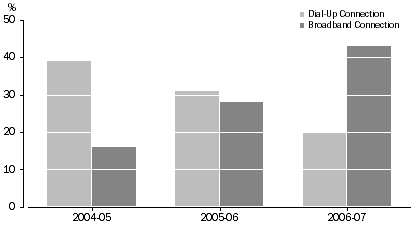
- The uptake of broadband Internet access varied across states and territories with the Australian Capital Territory reporting the highest proportion of households (58%) with broadband Internet access. In terms of region, both household and personal access to broadband Internet was more prevalent in metropolitan areas than in ex-metropolitan areas.
BROADBAND INTERNET ACCESS, by type of technology-2004-05 to 2006-07
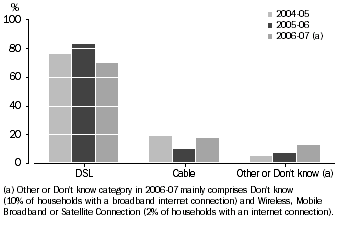
- Of the households with broadband access, the dominant type of technology used was Digital Subscriber Line (DSL), reported by 70% of households with broadband access, although the percentage of households using this type of technology had decreased by 13 percentage points.
- At the personal level, nearly three-quarters of people (72%) accessing the Internet at home used a broadband connection. High income earners, people with higher levels of educational attainment and younger people (15 to 24 years) registered relatively higher levels of broadband access.
- Overall, 61% of people aged 15 years and over accessed the Internet at home during 2006-07. Personal or private purposes was stated as the most popular purpose of Internet use at home (98% of those using the Internet at home), followed by education or study purposes (53%). 68% reported Personal or private purposes as the main purpose of Internet use, followed by Work or business related purposes (17%) and Education or study related purposes (12%).
MAIN PURPOSE OF INTERNET USE AT HOME, 2005-06 to 2006-07
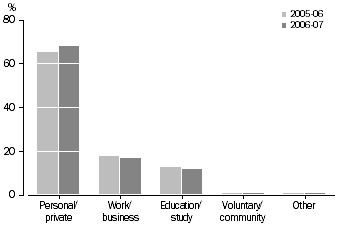
- In 2006-07, home was reported to be the most popular location of Internet use, with 61% of people aged 15 years or over using this location. An estimated 31% of people aged 15 years or over used the Internet from work. Aside from home or work, at 26% the next most popular site of Internet use in 2006-07 was a neighbour's, friend's or relative's home. Overall, 69% of people aged 15 years or over accessed the Internet from any location.
INTERNET USE by Location of Access - 2005-06 to 2006-07
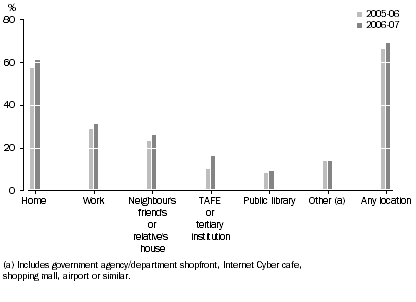
- In 2006-07, of the estimated 11.3 million people who accessed the Internet from any location, 61% used the Internet to purchase or order goods of services for private purposes. A higher proportion of people in Tasmania, the Northern Territory and the Australian Capital Territory (68%, 66% and 73%) used the Internet to purchase or order goods or services for private purposes.
Use of the Internet to Purchase or Order Goods or Services, by State/Territory-2006-07
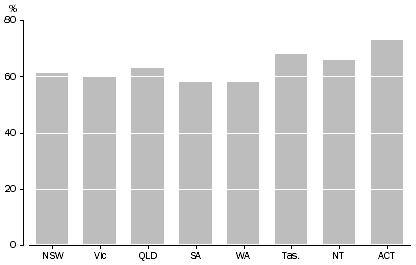
- The number of Australian households without access to home Internet decreased to 2.9 million households.
OTHER INFORMATION
The publication also contains further detailed information relating to computer and Internet use, including:
- Selected characteristics of households with computers or Internet access
- Selected characteristics of households without computers or Internet access
- Selected characteristics of persons using the Internet by location of access
- Selected labour force characteristics of persons using the Internet by location of access
- Selected characteristics of persons using the Internet at home by purpose
- Selected characteristics of persons using the Internet at home by main purpose
- Frequency of Internet use by location by selected characteristics of persons
- Selected characteristics of persons using the internet to purchase or order goods or services for private purposes
- Main reason for not using the internet to purchase or order goods or services for private purposes
- Selected characteristics of persons not using the internet, by location of access
- Type of Internet connection used by households or persons by selected household or person characteristics
- Type of technology used for broadband Internet access by selected household characteristics
- International comparisons for households with access to a home computer and the Internet
- International comparisons for households with broadband access.
 Print Page
Print Page
 Print All
Print All